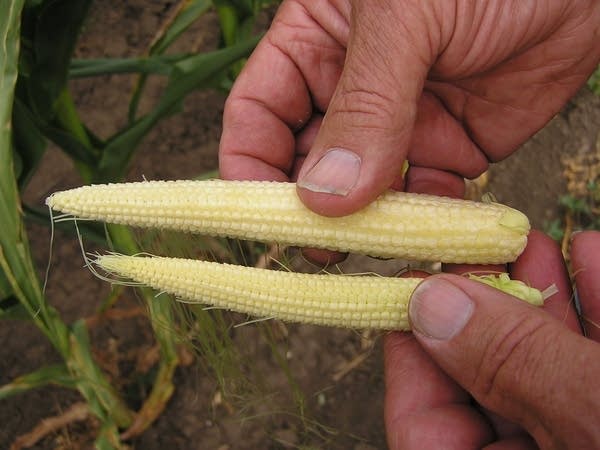Drought damages corn crop
Go Deeper.
Create an account or log in to save stories.
Like this?
Thanks for liking this story! We have added it to a list of your favorite stories.

As an unblinking sun pushes the temperature towards 90 degrees, farmer Ken Grooters leads the way into a corn field in southwest Minnesota. Puffs of pollen burst into the air from the top of each stalk as Grooters bends them out of the way. Miniature ears peek from the leaves of each plant.

Grooters breaks an ear off a nearby stalk. He pulls off the outer leaves revealing a still developing ear of corn. It's a little longer than his hand and about the diameter of a quarter.
"You can see where it's making kernels," says Grooters. "This ear looks pretty good I think."
The soil he's standing on shows just how dry things are. Cracks run through the black dirt.
Turn Up Your Support
MPR News helps you turn down the noise and build shared understanding. Turn up your support for this public resource and keep trusted journalism accessible to all.
Grooters says although the ear looks good now rain is needed or the kernels will shrivel. On the edge of the corn field that's already happening. Grooters plucks an ear that's a couple of inches shorter than the first one.
"This one here, it's pretty well stunted already," says Grooters.
"This one here, it's pretty well stunted already."
The two ears of corn demonstrate the precarious position of many Minnesota corn fields. They can go either way, boom or bust, depending on rainfall over the next few weeks.
At 77 years old, Grooters is semi-retired. His son handles most of the work on this Lincoln County dairy farm. Grooters still helps out though, driving machinery and and raising crops. He can see the corn's daily struggle with hot temperatures. In the morning the leaves look normal, as they soak up the morning dew.
"As you get to noon and then the real heat of the day, the corn tries to curl up, try to protect itself," says Grooters. "And then as it cools off in the evening why it'll look a little bit better again."
By curling the plant limits surface exposure to the sun, slowing evaporation. All of Minnesota's prime corn growing region is dry.
In most drought years farmers can count on significantly higher prices for what corn they manage to harvest. That's not the case this year.
Prices go up when the dry weather is widespread enough to sharply reduce the nation's harvest. Corn prices spiked briefly in July when it looked like a widespread drought was developing.
Prices quickly fell 10 percent or more when rains returned to key corn states like Iowa and Illinois. That left drought conditions mainly in Minnesota, North and South Dakota, as well as small parts of Iowa and Nebraska.

Alan May follows the corn market as part of his job with South Dakota State University's extension service. He says for now at least, grain traders are betting limited drought means limited impact on corn supplies and prices.
"If we continue to see production expectations for the national corn crop stay at least at current levels one would probably expect to see prices somewhat depressed by harvest, it would be a typical harvest time price pressure," says May.
For farmers with drought problems, that's bad news.
They have fewer bushels to sell and are getting a poor price. May says crop insurance will cover some of the losses. Federal farm subsidies will also help.
May says another approach is to hold off selling corn at harvest. He says corn prices for next year look better than what farmers will be able to get at the local elevator this fall.
Farmer Ken Grooters and his son will avoid most of the price concerns. Instead of selling corn, they feed it directly to the dairy cows. It's one advantage they have in a mostly bad drought outlook. As he scans the skies, Grooters says the fall harvest has been reduced to a simple equation.
"If we could get rain real quick I think we could still get a pretty decent crop," says Grooters. "But every day without rain right now it's deteriorating."
This area is rated as moderate drought. That's not quite as bad as the extreme drought conditions in parts of central and northern Minnesota, but it's bad enough. Grooters has seen only showers the past month, not enough to pull the corn crop out of its slow slide.



